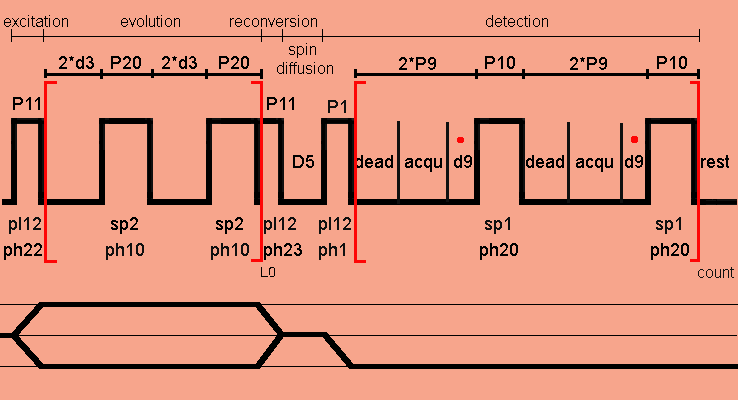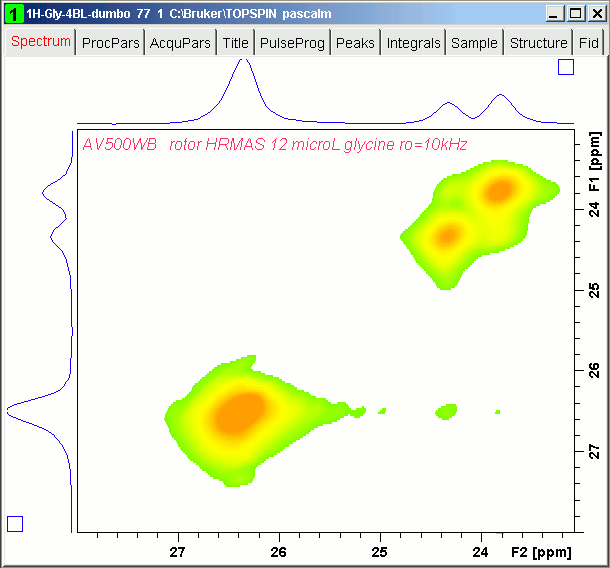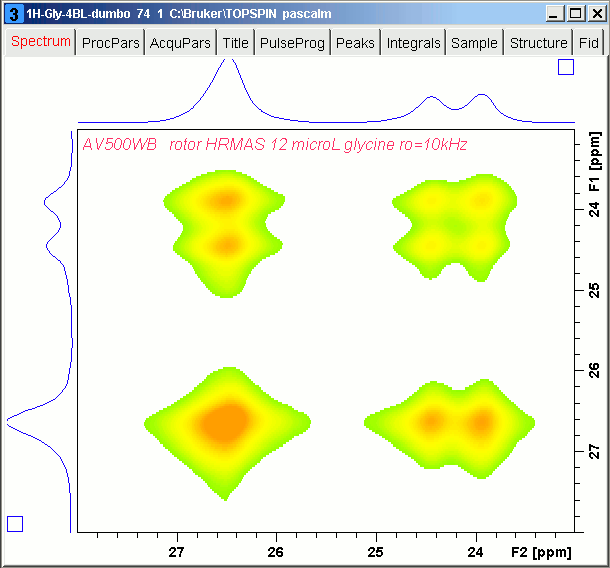
DUMBOspindiff: spin diffusion pulse program

Two-phase cycling is applied to the excitation pulse (1st prepulse P11) for filtering SQ coherences, non-phase cycling for the reconversion pulse (2nd prepulse P11), and four-phase cycling is applied to the detection pulse P1 for selecting the 0Q -> -1Q coherence order jump.
;DUMBOspinddiff3.ppm ;modified after Leskes, Madhu and Vega, Chem. Phys. Lett. to remove center artefact ;using STATES-TPPI and digital mode acquisition ;This pulse program was written according to the corresponding DUMBO-sequence from ;the ENS-Lyon Pulse Program Library ;p9 2.4-4.5 usec, depending on probe deadtime, usually: ;for 200 and 300 MHz, CRAMPS probe required or use 4.5 usec, ;acqu or p9 must be as short as possible, avoiding dipolar coupling effects between DUMBO sequences, ;l11 or d9 must be as large as possible to improve S/N ratio, but keeping acqu positive, ;p1 : proton detection pulse ;p11: excitation and reconversion proton pulses ;p9 : 1.7-4.5 usec, depending on probe deadtime ;d1 : recycle delay ;d5 : z filter delay ;l0 : 0 as initial t1 ;l3 : t1-increment multiplier, usually 2-4, to reduce required number of rows ;l11: number of oversampled data points to be averaged into one dwell point ;pl12: 1H power for pulses ;sp1 : 1H power for w-dumbo-1 (t2) ;sp2 : 1H power for dumber-22 (t1) (usually somewhat less power than sp1 since there is no window) ; set to pl13 as in setup experiments ;FnMode: STATES-TPPI ;ns : = 4n ;$COMMENT=homonuclear decoupling with w-dumbo ;$CLASS=Solids ;$DIM=2D ;$TYPE=homonuclear decoupling ;$SUBTYPE=explicit acquisition ;$OWNER=hf ;cnst11 : to adjust t=0 for acquisition, if digmod = baseopt "acqt0=1u*cnst11" dwellmode auto #include <Avancesolids.incl> #include <Delayssolids.incl> "d3=p9" ;p9 sets the window to make sure it is in micorseconds "d9=0.1u*(l11)" ;set the sampling window, defined in Avancesolids.incl "blktr2 = 0.6u" ;this opens the transmitter gate 0.6 usec before the ;pulse, so the transmitter noise is not sampled "l0=0" ;reset F1 dwell counter "inf1=(l3*(2*d3+p20))*2" ;t1 increment "sp1=pl13" "sp2=pl13" define delay dead "dead=1.2u" define delay acqu ;small window, defined by d3, 2.5-4.5 usec depending "acqu=2*p9-1.2u-d9-.1u" ;on probe deadtime ;acqu or p9 must be as short as possible, avoiding dipolar coupling effects ;l11 or d9 must be as large as possible but keeping acqu positive define delay cycle "cycle=4*p9+2*p10+.1u" define loopcounter count "count=aq/cycle" ;make sure td datapoints are sampled define delay rest ;make sure sampling proceeds throughout the sequence "rest=aq-(count*cycle)" 1 ze ;acquire into a cleared memory 2 d1 ;recycle delay 1m rpp10 1m rpp20 10u reset1:f1 ;synchronise pulse and detection RF (p11 pl12 ph22):f1 ;excitation pulse 5 d3 d3 (p20:sp2 ph10^):f1 ;dumber-22 d3 d3 (p20:sp2 ph10^):f1 ;dumber-22 lo to 5 times l0 (p11 pl12 ph23):f1 ;reconversion pulse d5 pl12:f1 ;z filter delay STARTADC ;prepare adc for sampling, set reference frequency, ;defined in Avancesolids.incl RESETPHASE ;reset reference phase (p1 ph1):f1 ;proton detection pulse at pl12 .1u DWL_CLK_ON 7 dead acqu d9 RG_ON .1u RG_OFF ;take l11 complex data points (p10:sp1 ph20^):f1 ;w-dumbo, use 24 usec at 600 MHz or higher dead acqu d9 RG_ON .1u RG_OFF (p10:sp1 ph20^):f1 lo to 7 times count ;make sure td points are sampled rest 1u DWL_CLK_OFF 1m rcyc=2 d1 mc #0 to 2 F1PH(ip22, iu0) exit ;finished ph0= 0 ph1= 0 1 2 3 ;detection pulse phase ph10=0 2 ph20=0 2 ph22=0 2 ;excitation pulse phase ph23=0 ;reconversion pulse phase ph30=0 ;needed for acquisition, involved in RESETPHASE ph31=ph22 + ph1 ;involved in STARTADC ;the same data as ph31 = -ph22 + ph1

1H spin diffusion spectrum of glycine in a 4-mm diameter, 12-µL HRMAS rotor spinning at 10 kHz; P10 = 36 µs and mixing time D5 = 4 µs.
Pulseprogram parameters for DUMBOspinddiff3.ppm:
| General | |
| PULPROG | DUMBOspinddiff3.ppm |
| TD | 500 |
| NS | 8 |
| DS | 0 |
| SWH [Hz] | 20000.00 |
| AQ [s] | 0.0125750 |
| RG | 4 |
| DW [µs] | 25.000 |
| DE [µs] | 4.50 |
| CNST11 | 0.0000000 |
| D1 [s] | 5.00000000 |
| d3 [s] | 0.00000280 |
| D5 [s] | 0.00000400 |
| d9 [s] | 0.00000300 |
| inf1 [µs] | 83.20 |
| L0 | 0 |
| L11 | 30 |
| P9 [µs] | 2.80 |
| ST1CNT | 100 |
| acqu [s] | 0.00000130 |
| count | 150 |
| cycle [s] | 0.00008330 |
| dead [s] | 0.00000120 |
| rest [s] | 0.00008000 |
| Channel f1 | |
| NUC1 | 1H |
| P1 [µs] | 2.00 |
| P10 [µs] | 36.00 |
| P11 [µs] | 2.00 |
| P20 [µs] | 36.00 |
| PL1 [dB] | 3.80 |
| PL12 [dB] | 3.80 |
| SFO1 [MHz] | 500.2121980 |
| SP1 [dB] | 7.00 |
| SP2 [dB] | 7.00 |
| SPNAM1 | dumbo_1+0 |
| SPNAM2 | dumbo_1+0 |
| SPOAL1 | 0.500 |
| SPOAL2 | 0.500 |
| SPOFFS1 [Hz] | 0.00 |
| SPOFFS2 [Hz] | 0.00 |
Acquisition parameters:
| F2 | F1 | |
| Experiment | ||
| PULPROG | DUMBOspinddiff3.ppm | |
| AQ_mod | qsim | |
| FnMODE | States-TPPI | |
| TD | 500 | 200 |
| NS | 8 | |
| DS | 0 | |
| TD0 | 1 | |
| Width | ||
| SW [ppm] | 39.9830 | 24.0283 |
| SWH [Hz] | 20000.00 | 12019.231 |
| IN_F [µs] | 83.20 | |
| AQ [s] | 0.0125750 | 0.0083200 |
| Nucleus1 | ||
| NUC1 | 1H | 1H |
| O1 [Hz] | 12197.96 | 12197.96 |
| O1P [ppm] | 24.386 | 24.386 |
| SFO1 [MHz] | 500.2121980 | 500.2121980 |
| BF1 [MHz] | 500.2000000 | 500.2000000 |

1H spin diffusion spectrum of glycine in a 4-mm diameter, 12-µL HRMAS rotor spinning at 10 kHz; P10 = 36 µs and mixing time D5 = 20 ms.
Pulseprogram parameters for DUMBOspinddiff3.ppm:
| General | |
| PULPROG | DUMBOspinddiff3.ppm |
| TD | 500 |
| NS | 16 |
| DS | 0 |
| SWH [Hz] | 20000.00 |
| AQ [s] | 0.0125750 |
| RG | 4 |
| DW [µs] | 25.000 |
| DE [µs] | 4.50 |
| CNST11 | 0.0000000 |
| D1 [s] | 5.00000000 |
| d3 [s] | 0.00000280 |
| D5 [s] | 0.02000000 |
| d9 [s] | 0.00000300 |
| inf1 [µs] | 83.20 |
| L0 | 0 |
| L11 | 30 |
| P9 [µs] | 2.80 |
| ST1CNT | 100 |
| acqu [s] | 0.00000130 |
| count | 150 |
| cycle [s] | 0.00008330 |
| dead [s] | 0.00000120 |
| rest [s] | 0.00008000 |
| Channel f1 | |
| NUC1 | 1H |
| P1 [µs] | 2.00 |
| P10 [µs] | 36.00 |
| P11 [µs] | 2.00 |
| P20 [µs] | 36.00 |
| PL1 [dB] | 3.80 |
| PL12 [dB] | 3.80 |
| SFO1 [MHz] | 500.2121980 |
| SP1 [dB] | 7.00 |
| SP2 [dB] | 7.00 |
| SPNAM1 | dumbo_1+0 |
| SPNAM2 | dumbo_1+0 |
| SPOAL1 | 0.500 |
| SPOAL2 | 0.500 |
| SPOFFS1 [Hz] | 0.00 |
| SPOFFS2 [Hz] | 0.00 |
Acquisition parameters:
| F2 | F1 | |
| Experiment | ||
| PULPROG | DUMBOspinddiff3.ppm | |
| AQ_mod | qsim | |
| FnMODE | States-TPPI | |
| TD | 500 | 200 |
| NS | 16 | |
| DS | 0 | |
| TD0 | 1 | |
| Width | ||
| SW [ppm] | 39.9830 | 24.0283 |
| SWH [Hz] | 20000.00 | 12019.231 |
| IN_F [µs] | 83.20 | |
| AQ [s] | 0.0125750 | 0.0083200 |
| Nucleus1 | ||
| NUC1 | 1H | 1H |
| O1 [Hz] | 12197.96 | 12197.96 |
| O1P [ppm] | 24.386 | 24.386 |
| SFO1 [MHz] | 500.2121980 | 500.2121980 |
| BF1 [MHz] | 500.2000000 | 500.2000000 |